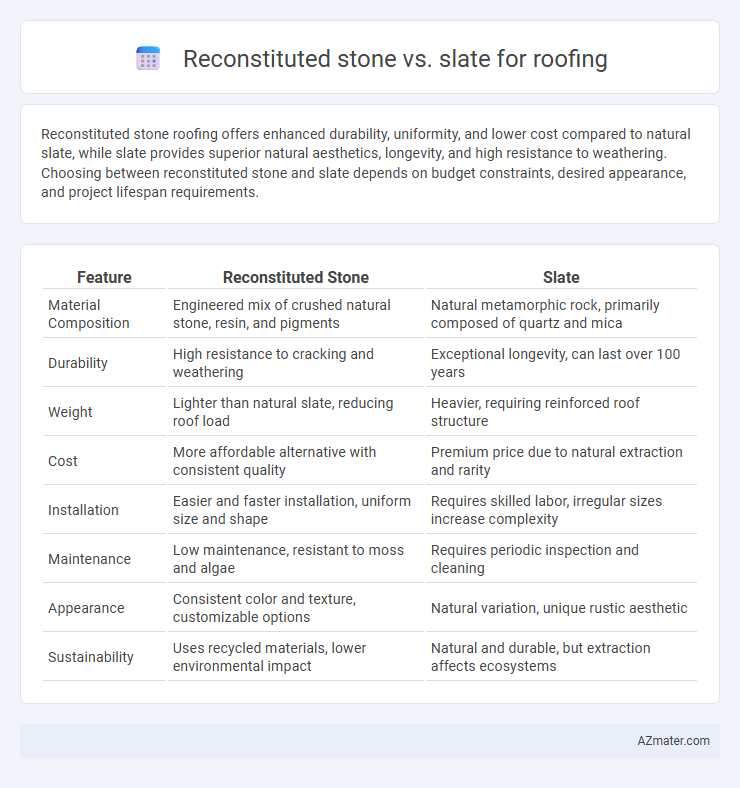Reconstituted stone roofing offers enhanced durability, uniformity, and lower cost compared to natural slate, while slate provides superior natural aesthetics, longevity, and high resistance to weathering. Choosing between reconstituted stone and slate depends on budget constraints, desired appearance, and project lifespan requirements.
Table of Comparison
| Feature | Reconstituted Stone | Slate |
|---|---|---|
| Material Composition | Engineered mix of crushed natural stone, resin, and pigments | Natural metamorphic rock, primarily composed of quartz and mica |
| Durability | High resistance to cracking and weathering | Exceptional longevity, can last over 100 years |
| Weight | Lighter than natural slate, reducing roof load | Heavier, requiring reinforced roof structure |
| Cost | More affordable alternative with consistent quality | Premium price due to natural extraction and rarity |
| Installation | Easier and faster installation, uniform size and shape | Requires skilled labor, irregular sizes increase complexity |
| Maintenance | Low maintenance, resistant to moss and algae | Requires periodic inspection and cleaning |
| Appearance | Consistent color and texture, customizable options | Natural variation, unique rustic aesthetic |
| Sustainability | Uses recycled materials, lower environmental impact | Natural and durable, but extraction affects ecosystems |
Introduction to Reconstituted Stone and Slate Roofing
Reconstituted stone roofing offers a durable, cost-effective alternative to natural slate, combining crushed stone, cement, and pigments to mimic the appearance of traditional slate while enhancing weather resistance and ease of installation. Slate roofing, made from natural metamorphic rock, is prized for its longevity, natural beauty, and fire-resistant properties, often lasting over a century with minimal maintenance. Both materials serve as premium roofing options, with reconstituted stone providing versatility and slate delivering timeless elegance and proven durability.
Composition and Manufacturing Differences
Reconstituted stone for roofing is made from crushed natural stones combined with resins and pigments, molded under heat and pressure to create uniform and lightweight tiles. Slate, a metamorphic rock, is quarried in large slabs and split into thin sheets, preserving its natural mineral layers and durability. The manufacturing of reconstituted stone allows for consistent thickness and color variations, whereas slate depends on natural geological formations resulting in unique textures and increased weight.
Aesthetic Appeal and Design Options
Reconstituted stone offers a versatile range of colors, textures, and shapes, allowing for customizable roofing solutions that mimic natural materials while maintaining uniformity. Slate provides a timeless, elegant aesthetic with unique variations in texture and color that develop naturally over time, enhancing the roof's character and value. Both materials support diverse design preferences, but reconstituted stone excels in adaptability and consistent appearance, whereas slate is prized for its authentic, classic charm.
Durability and Lifespan Comparison
Reconstituted stone roofing offers enhanced durability through consistent manufacturing standards, resisting cracking, chipping, and weathering better than natural slate. Slate, known for its natural formation over millions of years, provides exceptional longevity often exceeding 100 years, while high-quality reconstituted stone tiles typically last 30 to 50 years. The lifespan of reconstituted stone depends on factors such as resin quality and installation, whereas slate's natural mineral integrity ensures superior resistance to environmental degradation.
Cost Analysis: Installation and Maintenance
Reconstituted stone roofing generally offers lower installation costs compared to natural slate due to its lighter weight and easier handling, reducing labor expenses. Maintenance costs for reconstituted stone are also typically less, as the material is more resistant to cracking and weathering than slate. However, slate's durability and longevity can lead to lower long-term maintenance expenditures despite higher initial installation costs.
Environmental Impact and Sustainability
Reconstituted stone roofing offers enhanced sustainability by utilizing recycled materials and reducing quarrying impacts compared to natural slate, whose extraction results in significant environmental disruption and higher embodied energy. Slate's longevity and natural durability mean less frequent replacement, which can offset some environmental costs over time, while reconstituted stone provides a balance of eco-friendliness and cost-effectiveness through its lower carbon footprint during production. Both materials contribute to sustainable roofing choices, but reconstituted stone is increasingly favored for its ability to minimize environmental degradation and support circular economy principles.
Weather Resistance and Performance
Reconstituted stone offers enhanced weather resistance due to its engineered composition, which provides greater durability against freeze-thaw cycles and moisture infiltration compared to natural slate. Slate, while naturally dense and water-resistant, may be prone to cracking under extreme temperature variations, impacting long-term performance. The engineered consistency of reconstituted stone ensures uniform strength and longevity, making it a reliable choice for roofing in harsh weather conditions.
Weight and Structural Considerations
Reconstituted stone typically weighs less than natural slate, reducing the overall load on the roof structure and making it suitable for buildings with limited support capacity. Slate, known for its high density and durability, imposes a heavier load that requires stronger structural reinforcement to prevent sagging or damage over time. Choosing between the two depends on balancing the advantages of slate's natural strength with the lighter, more versatile nature of reconstituted stone for specific architectural needs.
Installation Process and Timeframe
Reconstituted stone roofing offers a faster installation process compared to natural slate due to its uniform size and lighter weight, allowing for easier handling and fewer special tools required. Slate roofing installation demands skilled labor and more time because each tile must be carefully aligned and secured, often taking several days longer than reconstituted stone. The efficiency of reconstituted stone reduces overall project duration, making it a preferred choice for time-sensitive roofing projects.
Choosing the Right Roofing Material for Your Project
Reconstituted stone offers consistency, durability, and a wide range of colors, making it a versatile choice for roofing projects requiring uniform appearance and long lifespan. Slate provides natural beauty, exceptional longevity, and resistance to fire and weather, ideal for historic or high-end architectural designs demanding premium materials. Evaluate factors such as budget, aesthetic preferences, climate conditions, and maintenance requirements to select the roofing material that best suits your project goals.

Infographic: Reconstituted stone vs Slate for Roofing
 azmater.com
azmater.com